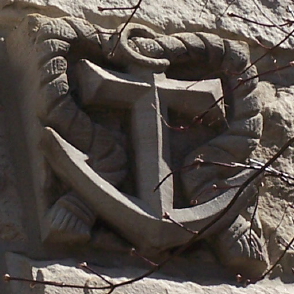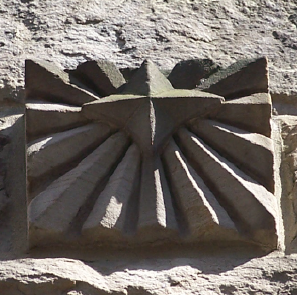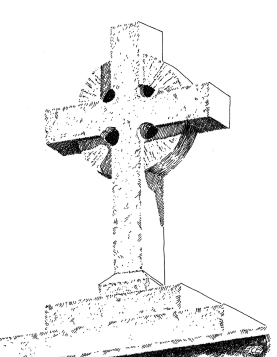The Cross is the most widely recognized symbol of Christianity. And, while the Gospels and the Epistles speak of its overarching significance to the earliest believers, the Cross was not always openly displayed. By the third century, Christians made the sign of the Cross on their foreheads. However, as a physical artifact, the Cross was disguised during the first centuries after Christ, when persecution was widespread. The open use of various forms of Christian Crosses at Shadyside Church was not a practice of the Early Church until the late fourth century.

The cross shape was sometimes hidden within other symbols, such as the mast of a ship or an anchor. The anchor is one of the carved medallions on the front façade of Shadyside’s Parish Hall. As such, it recalls two aspects of Christ. In addition to his atoning sacrifice through crucifixion, we find in Hebrews 6:19-20, “… this hope as an anchor for the soul, firm and secure. It enters the inner sanctuary behind the curtain, where Jesus, who went before us, has entered on our behalf…”


Not far from the anchor is a medallion with two symbolic references. In the Cross Etoile or Star Cross, we are reminded of the heavenly guide for the Magi after the birth of Jesus as well as the instrument of his death.
Two other medallions incorporate small crosses within their symbols. The symbol for Peter is crossed keys, referring to the authority of the church given by Christ through the Disciple. Within the bit of each key, we see the Latin Cross. More subtle, are crosses on the loaves in the medallion that recalls the miraculous feeding of the multitude by Jesus.


Before departing the Parish Hall, we note a Cross related to the Scots-Irish Presbyterianism of Western Pennsylvania. The form of the Celtic Cross predates its Christian symbolic use. There are numerous ancient examples, some associated with pagan religious practice. No definitive explanation is available for the Christian adoption of a superimposition of circle and cruciform. One particularly romantic story claims that the circle was used among pagans to identify a person to be sacrificed. The person on whom the circle focused the sun’s rays was to die. The placement of the Cross over the circle blocks the rays and signifies that Christ has become the sacrifice for everyone.

Two more Crosses are found outside at Shadyside. At the peak of all four main gables, an equal-armed Greek Cross is found, mounted within a circle. The use of a Greek Cross may allude to the Byzantine influence on Romanesque architecture and its various revivals. Below this example on the front façade is a Latin Cross covered with foliate carving. The graceful tapering at the ends of the Cross members is a variation on this most common Christian symbol in the Western Church.

As a result of post-Reformation iconoclasm and mistrust of the Roman Catholic Church, Protestant churches often rejected the display of Crosses in worship. This suspicion of explicit symbolism began to diminish in the mid-1800s, but was still somewhat common through the first half of the twentieth century.

In Shadyside’s chancel and nave, only the gold Cross on the communion table is found. It was added only after the 1938 remodeling of the sanctuary. Apparently, some skepticism remained and the compromise acceptance required a simple Cross. Shortly after its addition, however, the bright red backing was added to make the Cross more prominent.
 When this feature was published in the predecessor website, I forgot about the Cross in the chapel chancel. It was carried over from the 1950s chapel as it existed before the 2010 remodeling. And so, we find only two Crosses within the building, and those of relatively recent origin. Of the eight outside, five were part of the original 1890 structure. The remaining three are a part of the Parish Hall, erected in 1953.
When this feature was published in the predecessor website, I forgot about the Cross in the chapel chancel. It was carried over from the 1950s chapel as it existed before the 2010 remodeling. And so, we find only two Crosses within the building, and those of relatively recent origin. Of the eight outside, five were part of the original 1890 structure. The remaining three are a part of the Parish Hall, erected in 1953.

Careful observers will notice that, when I composed this feature several years ago, I omitted the cross in the chancel of Shadyside’s chapel, which is shown in the preceding feature “I Wish I Could Have Seen It.”
LikeLike